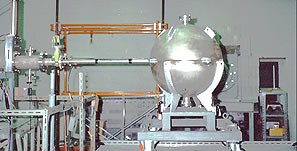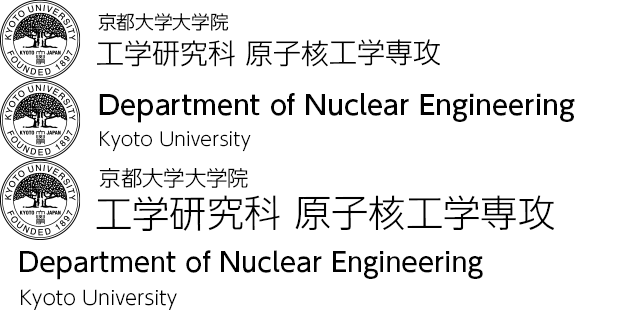Neutron Sources and Applications
We are conducting the following research works:
- Development and advanced utilization of nuclear reactors and accelerator-driven neutron sources,
- Investigations of neutron behavior in nuclear fuels and other materials, nuclear reactions, and nuclear transmutation,
- Development of diagnostic technique for structural integrity of nuclear facilities, and their safety evaluation.
Academic Staff
Ken NAKAJIMA
 Professor (Institute for Integrated Radiation and Nuclear Science)
Professor (Institute for Integrated Radiation and Nuclear Science)
Research Theme
Experimental Reactor physics using Research Reactors, Neutronics of Accelerator Driven System(ADS), Criticality safety and Criticality accident analysis.
Classes
Reactor Safety Engineering, Advanced Experiments on nuclear engineering
Contact Information
Institute for Integrated Radiation and Nuclear Science
TEL: +81-72-451-2457
FAX: +81-72-451-2658
E-mail: nakajima@* (Add "rri.kyoto-u.ac.jp" after @)
Yoshihiro ISHI
Associate Professor (Institute for Integrated Radiation and Nuclear Science)
Research Theme
We are developing accelerator driven neutron sources. Main research subjects are investigation of an accelerator system which provides high intensity and efficiency of neutrons and beam dynamics in the accelerator.
Contact Information
Toshiharu TAKAHASHI
 Associate Professor (Institute for Integrated Radiation and Nuclear Science)
Associate Professor (Institute for Integrated Radiation and Nuclear Science)
Research Theme
Development of the accelerator-based intense light source in the terahertz region and its application to the spectroscopic research
Contact Information
Institute for Integrated Radiation and Nuclear Science (Kumatori Campus) Research Bldg.
TEL: +81-72-451-2409
FAX: +81-72-451-2602
E-mail: takahasi(A)rri.kyoto-u.ac.jp
Toshihiro YAMAMOTO
 Associate Professor (Institute for Integrated Radiation and Nuclear Science)
Associate Professor (Institute for Integrated Radiation and Nuclear Science)
Research Theme
Reactor Physics, Neutron transport calculation by Monte Carlo method
Contact Information
Institute for Integrated Radiation and Nuclear Science
TEL: +81-72-451-2414
FAX: +81-72-451-2620
E-mail: tyama(at)rri.kyoto-u.ac.jp
Jun-ichi HORI
Associate Professor (Institute for Integrated Radiation and Nuclear Science)
Research Theme
Contact Information
TEL: +81-724-51-2427
FAX: +81-724-51-2620
E-mail: hori@* (Add "rri.kyoto-u.ac.jp" after @)
Tomonori UESUGI
Assistant Professor (Institute for Integrated Radiation and Nuclear Science)
Research Theme
Contact Information
FAX: +81-724-51-2620
E-mail: touesugi@* (Add "rri.kyoto-u.ac.jp" after @)
Yasutoshi KURIYAMA
Assistant Professor (Institute for Integrated Radiation and Nuclear Science)
Research Theme
Contact Information
TEL: +81-72-451-2329
E-mail: kuriyama@* (Add "rri.kyoto-u.ac.jp" after @)
Tadafumi SANO
Assistant Professor (Institute for Integrated Radiation and Nuclear Science)
Research Theme
Contact Information
Research Topics
Benchmark experiment on fusion reactor materials and validation study of their nuclear data
In the neutronics calculation of the fusion reactors, the uncertainty introduced in the reactor design strongly depends on the neutron interaction database, which is generally called as evaluated nuclear data. Currently, several nuclear data are available including JENDL-3.2 from JAERI, Japan. Though these data are compiled based upon experimental results and new neutron reaction theories, they have to be validated through the experiment. Benchmark experiment is conducted for this purpose, in which the accurate experimental values are acquired using a clear geometry and a sample with a simple composition, and are compared with the calculated values using these nuclear data.
In this research, leakage neutron spectra from the samples of fusion reactor related materials are accurately measured with 14 MeV neutrons using time-of-flight method. From the comparison between the measured and calculated spectra, the problems in the nuclear data are extracted. In order to find out the cause for the problems, sensitivity analysis are conducted in numerical way. The measured data include 14 elements and compounds - Li, F, Si, Ti, Cr, Mn, Co, Cu, As, Se, Zr, Nb, Mo and W. These data are officially available through the Nuclear Data Section of IAEA

Figure 1:Sample pile with 60 cm diameter. Pulsed deuteron beam incidents from the left and generates 14 MeV neutrons via d(3T,n)4He reactions. The neutrons enter the sample and after various kinds of interactions with the sample materials, the leakage neutron spectrum is formed. This is measured with a neutron detector using a time-of-flight method.

Figure 2:The Measured spectrum from a 61 cm Zr pile and the calculated one with a Monte Carlo neutron transport code. By studying the difference between these two, the accuracy of the nuclear data for Zr are validated and proceeded to the improvement of the data.
Experimental studies on neutron reaction data of minor actinides and long-lived fission products
Nuclear data of minor actinides (MA) are indispensable for their production and burn-up evaluations. However, those data are insufficiently-prepared for such evaluations. We, then, have been conducting experimental researches to obtain the nuclear data, using an electron linear accelerator (linac), for the minor actinides such as Np-237, Am-241, 242m, 243, Th-229, and Pa-231, by the time-of-flight technique and/or a lead slowing-down spectrometer. Additionally, the nuclear data for long-lived fission products (LLFP) are also insufficient for the nuclear transmutation or incineration. Thus, the neutron capture cross sections for such nuclides as Tc-99, Rh-103, In-115, I-129, Cs-133, and Pr-141 have been measured using the linac and/or the lead slowing-down spectrometer. Up to now, we have measured the nuclear data of MA and LLFP, which were poorly obtained before, using the linac with the time-of flight technique, and have provided the reliable data.

Figure 3:Measured neutron capture cross section of Np-237
Study for increasing the seismic safety of nuclear plants
A study related to seismic safety is one of important subjects for nuclear plants in Japan. Strong ground motions generated from active faults have been predicted to estimate seismic force during earthquakes. Furthermore, the studies for increasing the accuracy of predicted input motions have been done by using the empirical as well as physical data.
